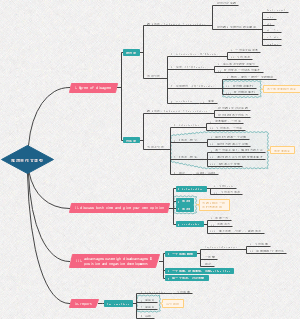导图社区 限定词(二)——冠词用法
- 84
- 0
- 0
- 举报
限定词(二)——冠词用法
第八章限定词(二):冠词 33.不定冠词a,an的位置 不定冠词a用在以辅音音素(并非辅音字母)开头的名词前;不定冠词an用在以元音音素开头的名词前。例如: a. a boy,a student b. a univsersity,a unique person,an unkind old lady c.an hour,an honor d.An apple a day keeps the doctor away. 一天一苹果,医生远离..
编辑于2022-11-21 23:27:04 福建省- 人称代词
英语中人称代词(Personal Pronoun)意为用于直接指代人或者事物的代词,属于代词范畴,就像汉语中的“你”、“我”、“他”。常用的英语人称代词有:I、you、he、she、it(主格)。人称代词在句中作不同成分时有不同的形式,如:主格...
- 限定词(二)——冠词用法
第八章限定词(二):冠词 33.不定冠词a,an的位置 不定冠词a用在以辅音音素(并非辅音字母)开头的名词前;不定冠词an用在以元音音素开头的名词前。例如: a. a boy,a student b. a univsersity,a unique person,an unkind old lady c.an hour,an honor d.An apple a day keeps the doctor away. 一天一苹果,医生远离..
- 限定词(一)
这是一篇关于限定词(一)的思维导图,主要内容有限定词与三类名词的搭配关系、限定词与限定词的搭配关系、限定词的表意功能等。
限定词(二)——冠词用法
社区模板帮助中心,点此进入>>
- 人称代词
英语中人称代词(Personal Pronoun)意为用于直接指代人或者事物的代词,属于代词范畴,就像汉语中的“你”、“我”、“他”。常用的英语人称代词有:I、you、he、she、it(主格)。人称代词在句中作不同成分时有不同的形式,如:主格...
- 限定词(二)——冠词用法
第八章限定词(二):冠词 33.不定冠词a,an的位置 不定冠词a用在以辅音音素(并非辅音字母)开头的名词前;不定冠词an用在以元音音素开头的名词前。例如: a. a boy,a student b. a univsersity,a unique person,an unkind old lady c.an hour,an honor d.An apple a day keeps the doctor away. 一天一苹果,医生远离..
- 限定词(一)
这是一篇关于限定词(一)的思维导图,主要内容有限定词与三类名词的搭配关系、限定词与限定词的搭配关系、限定词的表意功能等。
- 相似推荐
- 大纲
限定词(二)——冠词用法
冠词的类指和特指
冠词的类指用法
the+n(单数)
the horse
the+adj/vpp
the sick
the oppressed
a/an+n(单数)
an ox/a lawyer
零冠词+n(复数/不可数)
Unity is strength.
冠词的特指用法
确定特指Definite Specific Reference
定冠词
The dog and the cat are the same ones we had last year.
非确定特指Indefinite Specific Reference
不定冠词
I have lost a button.
零冠词
She put carrots in the stew.
后照应特指、前照应特指、语境特指
后照应特指:也叫“回指”,是说指代对象出现在上文
e.g. Yesterday a beggar knocked at my door. He asked me for a meal and a glass of beer. In return for this, the beggar stood on his head and sang songs. (特指上文提到的“a beggar”)
前照应特指:也叫“下指”,是说所指意义取决于下文的后置修饰语
e.g. During the summer, I noticed that the leaves of the tree were beginning to wither.
语境特指:所指意义不取决于上下文,而是完全取决于语境或共有知识
e.g. Shut the door, please. (说话双方都知道的“那扇开着的门”)
各类名词前的冠词用法
冠词与专有名词
1. 一般规律
大多数人名、地名、西方节日名称前不用定冠词
e.g. Shakespeare,London Bridge,Christmas
2. 带定冠词的特殊情形
(1)专有名词之前带有表职业或其他限制性修饰语时
e.g. the poet Keats,the young Shakespeare
(2)大洋、大江、大河、大海峡、大海湾、大运河;大沙漠、大山脉、大群岛及复数形式的地理名称前(地区、国家、列岛等)
e.g. the Pacific (Ocean),the Rhine,the Strait of Magellan,the Suez Canal;the Sahara,the Himalayas,the Penghu Islands,the Philippines
(3)个别岛、湾带of-后置修饰语时
e.g. the Isle of Wight (对比 Long Island) the Bay of Naples (对比 Hudson Bay,San Francisco Bay)
(4)多数公共组织、机构、建筑设施等名称前
e.g. the Senate,the British Museum,the BBC
(5)多数报纸、杂志名称前
e.g. The People’s Daily,The Times,The Economist
(6)带有festival的表节日的名词词组
e.g. The Spring Festival,The Dragon Boat Festival
冠词与普通名词
1. 在度量衡名称前常用定冠词,也可用不定冠词
e.g. We are paid by the hour / the piece. It sells at two dollars the pound / a pound.
2. 职位/头衔名称前常用零冠词,特别是作主语补语、宾语补语或同位语时
author,chairman,boss,captain,director,goalkeeper,head,king,president,manager,prime minister,secretary等
e.g. John F. Kennedy was (the) President of the United States in 1961. (主语补语) They elected him general manager of the company. (宾语补语) This is Professor Hunter, head of the delegation. (同位语)
3. 在school,church等机构处所名词前冠词的选择
bed,church,class,college,hospital,prison,school,table,university等这类名词与定冠词或不定冠词搭配,表示机构处所的本意;使用零冠词,表示机构处所的功能
e.g. in the bed / church / class / college / hospital / prison / school 在床上 / 教堂 / 班级里 / 大学里 / 医院里 / 监狱里 / 学校 in bed / church / class / college / hospital / prison / school 睡觉 / 做礼拜 / 上课 / 上大学 / 住院 / 坐牢 / 上学
4. 对“击打”身体部位等名词的特指,习惯上用定冠词,而不用物主限定词
基本结构:catch / grab / hit / hold / kick / kiss / pat / pull / seize / shake / strike / take / touch等动词 + 宾格 + 介词in / on / by + the + 身体部位
e.g. The branch sprang back and hit him in the face. (平坦、柔软的部位前常用in) He gave Mike a bash on the nose. (坚硬、突出的部位前常用on) The owner of the stall, a large, thuggish man, grabbed Dave by the collar. (可以扭住的部位常用by)
冠词的其他用法
1. 两个名词构成的对称结构中,名词一般用零冠词
(1)同一名词重复出现,一般具有副词功能
e.g. They talked face to face. (面对面地) The contestants went toe to toe with their rivals. (旗鼓相当地)
(2)不同名词为列举或排比起见并列使用
e.g. We should serve the people heart and soul. (全心全意地) The poor man lived from hand to mouth.(仅能糊口地)
2. 某些介词词组中名词词组带定冠词和零冠词的语义区别 区别
带定冠词,通常表示名词的本义
① at the bottom of 在…的底部 ② in the future 将来 ③ at the end of 在…的尽头 ④ in the hand 在手中 ⑤ at the top of 在…的顶端 ⑥ after / in the fashion of 依照… ⑦ in the front of 在(内部)…的前面 ⑧ in the case of 至于;就…而言 ⑨ in the possession of 为…所拥有(有被动含义)
零冠词,通常表示名词比喻或引申义
at bottom 本质上;实际上 in future 从今以后 on end 连续地 at hand 在附近;即将发生 on top of 除…之外;在…之上 in fashion 时兴;流行 in front of 在(外部)…的前面 in case of 如果;假若…的话 in possession of 拥有(有主动含义)
3. 用零冠词的其他常见情形
(1)在独立结构中,单数可数名词前用零冠词 (表典型的物体)
e.g. Eugene, cigar in mouth and pen in hand, tossed him his card. The old man was sitting in a chair, pipe in mouth.
(2)在倒装的让步状语从句中(as,though引导),作主语补语的名词前用零冠词
e.g. Fool as he is, John could not have done such a thing. She has more sense than Mary, child though she is.
(3)两个单数名词连用,表示同一个人或成套的两件东西,第二个名词前用零冠词
e.g. He is a journalist and author. (记者兼作家) There is a horse and cart on the road. (一辆马车)
(4)在“kind / sort / type + of”等结构后的单数名词前,常用零冠词
e.g. I really feel aggrieved at this sort of thing. What type of car are you looking for?









